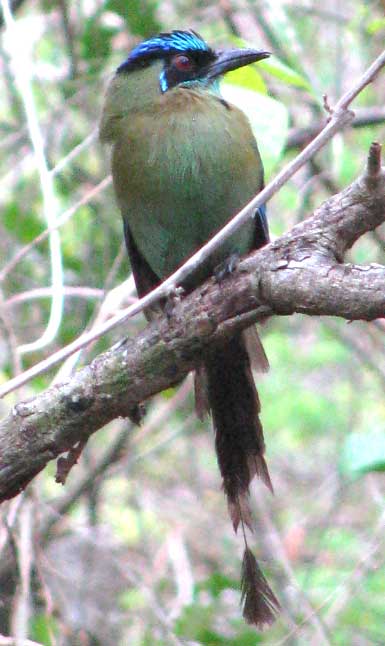Excerpts from Jim Conrad's
Naturalist Newsletter
from the April 25, 2010 Newsletter issued from Hacienda Chichen Resort beside Chichén Itzá Ruins, central Yucatán, MÉXICO; limestone bedrock, elevation ~39m (~128ft), ~N20.676°, ~W88.569°
MOTMOT AT BREAKFAST

During my first four months here the only motmots seen were Turquoise-browed Motmots, which you can compare at www.backyardnature.net/yucatan/motmottq.htm.
But a little over a month ago this Blue-crowned arrived and hasn't left. If you compare the above pictures you can see that the two species are very similar. The Blue-crowned has a black crown while the Turquoise's is greenish. The most easily seen difference, though, is that the open spaces in the tail feathers (bare tail shafts) of the Blue-crowned Motmot are much smaller than those of the Turquoise-browed.
There's a story behind why the Blue-crowned Motmot in the picture belies its name by having a black crown. The species is distributed over a large area, from northeastern Mexico through all of Central America to Peru and Argentina, and presents several races or subspecies. In northeastern Mexico the subspecies coeruliceps does have a blue crown, but our subspecies lessonii has a black one. Apparently someone who saw the blue-crowned type got to give the species its English name.
In the Yucatan we have only these two motmot species, though six species occur in all of Mexico. In other places I've stayed at in the Yucatan we always had one species but not both. My impression is that the two species are so in competition for the same ecological niche that they don't like the other species in their territories. I've seen a Turquoise-browed chase the Blue-crowned pretty hard, even though the Turquoise-broweds are smaller (13-15 inches) than the Blue-crowneds (15-17 inches). Maybe that's why my morning visitor is missing a racket tip.